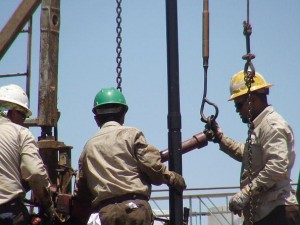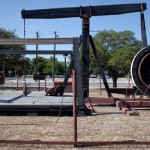Shale Boom Has Major Impact on Texas’ Budget

Photo by MIRA OBERMAN/AFP/Getty Images
The rise of drilling techniques like hydraulic fracturing, or "fracking," has led to new economic prosperity in Texas. (Photo of a Cabot natural gas drill at a fracking site in Pennsylvania.)
From the Texas Tribune:
The impact of the recent boom in shale drilling is hard to miss in some remote Texas towns, where hotels and homebuilders scramble to keep up with the influx of oil and gas workers.
But the most significant effect from the boom may be seen in the state’s coffers. Taxes on oil and gas production have soared past estimates from the state’s comptroller’s office for fiscal 2012. And with production expected to continue to rise over the next several years, the economic benefits will continue.
James LeBas, a fiscal consultant who also works as a lobbyist for the Texas Oil and Gas Association, estimates that oil and gas interests paid about $12 billion in taxes in Texas in fiscal 2012, up from $9.25 billion in 2011 and $7.4 billion in 2010. That included taxes on property, sales and production, as well as the franchise tax and indirect items like taxes on motor fuels.
“It would be unambiguously positive for the state fiscal situation and local [economies], if oil production continues to rise,” LeBas said. “For most of my lifetime, it has been falling.”
Driven by high oil prices and advanced rock-breaking technologies, oil production indeed appears set to rise. Barry Smitherman, the chairman of the Texas Railroad Commission, said in a January interview that Texas could roughly double its oil production, to 3 million barrels per day by 2020. (The state currently produces about 1.7 million barrels of oil a day.)
“These are OPEC-like numbers,” Smitherman said, adding, “We’re producing so much oil and gas in Texas that we’re rapidly getting to the point where America can reduce its dependency on imported oil.”
Last fiscal year, oil and gas production taxes — also known as severance taxes — came in far above the comptroller’s estimates (which are known to be conservative). Tax income from oil production and regulation was 43 percent higher than estimated, at $2.1 billion, and the natural gas production tax brought in $1.5 billion, 38 percent higher than estimated.
The production taxes are perhaps the most visible of the payments made by oil and gas. That’s because this type of tax fuels the state’s Rainy Day Fund, which lawmakers are currently considering tapping to pay for infrastructure projects like water. The fund has about $8 billion, and that number is projected to rise to $11.8 billion by the end of the 2014-15 biennium, according to the comptroller’s office.
Property taxes, which go toward local governments, are also significant — about $3.6 billion was collected from oil and gas interests in 2012, roughly equivalent to the amount of oil and gas production taxes that year. Sales taxes from oil and gas totaled $2.5 billion in fiscal 2012.
The recent breakneck growth may calm slightly in fields like the Eagle Ford Shale, analysts say. That’s because the pumpjacks often bring up oil the fastest shortly after the wells are drilled, and then the pace slows down in later years. In the Eagle Ford, “our expectations [are] for production to continue to grow through the decade but at a much slower rate,” Stephen Richardson, a Deutsche Bank research analyst, said in an email.
Still, with oil prices relatively high, at $90 a barrel, the search for more oil and new shales is in full swing. From the perspective of the state budget, exploration can be an especially lucrative activity, according to Dale Craymer, president of the Texas Taxpayers and Research Association.
“The search for oil is a huge jobs creator,” Craymer said. “It’s also a huge tax creator.”
Companies exploring for oil may buy heavy equipment to drill, and that means sales tax revenues for the state.
“Almost everything they buy is taxable,” LeBas said, citing as an example a diamond-tipped drill-bit that can go for $40,000.
Higher oil prices, though they hurt Texans at the gas pump, remain a net benefit to the state’s economy, according to Mine Yücel, a vice president and senior economist at the Federal Reserve Bank of Dallas.
“When oil and gas prices go up, for the nation — that’s costly,” Yücel said. “That hurts the nation overall. … For Texas, it’s the other way around.”
Some industries, of course, benefit from low fossil fuel prices. The petrochemical industry, for example, has enjoyed a boom thanks to low natural gas prices, which have slipped considerably from 2008 highs.
The Texas economy is not as dependent on oil as it once was. In 1981, just before oil prices began a steep slide after their highs in the 1970s, oil and gas accounted for 18 percent of the state’s GDP. In 2011, it was just above 8 percent.
The slide hurt the state’s economy, which has diversified since then. Still, a 2011 report from the Dallas Fed found that a 10 percent rise in oil prices leads to gains of 0.5 percent for the state’s GDP.
With the national shale boom on, Texans are also in demand to work on oil and gas drilling in other states, Yücel noted. Texas has the largest oil and gas field “services” sector — like trucking and hydraulic fracturing fluid production that support the drillers themselves. It’s “much, much higher than the rest of the nation,” she said.

